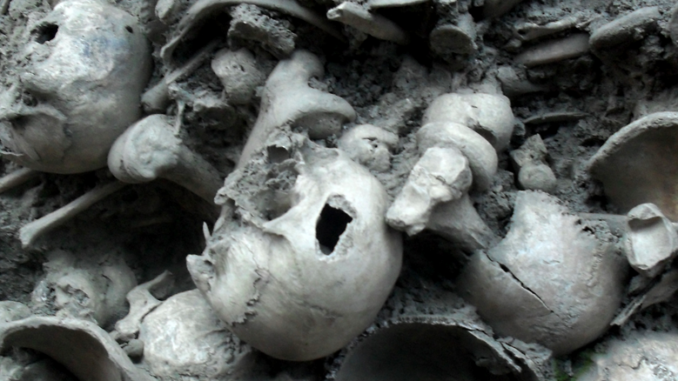
“MEXICO CITY—State authorities discovered 168 human skulls buried in a clandestine grave in the violence-plagued state of Veracruz, the state’s general attorney said Thursday, unearthing more gruesome evidence of Mexico’s epidemic of cartel-related kidnapping and murder,” the Wall Street Journal reported last Thursday.
That number had been updated from 166 to 168 by Thursday evening.
Jorge Winckler, Veracruz’s state prosecutor said in an interview statement it was “the second-largest mass grave found in Veracruz in recent years,” adding that “the state has become a cemetery,” and that of Veracruz’s 212 municipalities, mass graves have been found in more than half.
Veracruz is located in the easternmost part of central Mexico sitting on the Gulf of Mexico and serves strategically as an important port, with mass graves becoming synonymous with the drug cartel plagued Gulf port state with more than 700 people currently missing over recent years, becoming a scene of “bloody turf battles between the Zetas and Jalisco drug cartels” suffering “waves of kidnappings and extortion’s.”
The Los Zetas, what is left of them after being decimated by federal authorities, were formed by “ex-soldiers from Mexican special forces units.” The Jalisco are referred to as the “New Generation Cartel,” and are the ‘fastest rising drug cartel” right now, and along with what is left of the Zetas, the “Mexican Navy, law enforcement and members of various armed factions” have been involved in groups who engage in the drug-trafficking and turf wars.
After being tipped off by an informant, Winckler said, they began the search more than a month ago. It’s become a common occurrence for how these mass graves have been discovered, when, it is believed, inside people will deliver hand drawn notes with directions. As it was in this case, Winckler said, “after a witness told them that “hundreds of bodies” were buried there,” the AP News reported.
“In 2016 and 2017, Veracruz investigators found 253 skulls and bodies in burial pits outside the state capital, after relatives of missing people said they received a hand-drawn map from someone detailing the location of the graves.”
Investigators believe the bodies have been there for at least two years and they are not ruling out more remains will be found, the AP said at the time of their reporting, adding that investigators had found so far, in addition to the skulls, “114 ID cards in the field, which held about 32 burial pits.”
Winckler would not reveal where this site was specifically located for fear for the safety of the people involved in the recovery process, nor were the families of those who have reported missing relatives included, to help maintain secrecy for safety purposes.
The disappeared are so prevalent activist groups consisting of mothers, relatives, and friends of the missing help in searching. Groups like Red de Madres de Veracruz – Veracruz Mothers Network, Causa en Común – Cause in Common and Colectivo Solecito -Solecito Collective.
It was in August 2016, according to the WSJ, that “a group of grieving mothers searching for their disappeared children, acting on an anonymous tip, led investigators to a site that eventually yielded 289 human skulls, thought to be the largest mass grave in Mexican history.”
Lucia Diaz who joined Colectivo Solecito in 2013 when her son was kidnapped commented Winckler broke a law that was recently passed saying the family must be included, according to the AP report.
“We don’t trust the work they do, we have a lot of reasons,” Diaz said, noting that in one past case investigators excavated too quickly and pulled bodies out in pieces.” “In this case they took out 166 bodies in one month? It cannot have been done properly. It’s impossible, too quickly,” adding that “he (Winckler) went against the law, because the law says the families have a right to participate now.”
It has long been believed that many of the mass graves found are from a period of 2010-2016 that lawlessness spiked when then Veracruz’s governor Javier Duarte di Ochoa, who is now in jail on charges of embezzlement while awaiting trial along with his former police chief Arturo Bermudez who is charged with “enforced disappearance.”
The Independent reported that Ochoa was “a member of Mexican president Enrique Pena Nieto’s Institutional Revolutionary Party who governed the state until 2016.”
According to the WSJ, the national registry of missing people showed “more than 37,000 people were missing and unaccounted for in Mexico by the end of April,” and that “more than 31,000 people were murdered in the country last year, the most in any year of the last two decades.”
Mexico’s president-elect Andres Manuel Lopex Obrador takes office on December 1. Ricardo Monreal who is a member of Obrador’s Morena party and a majority leader in Mexico’s Senate said, “The outrageous levels of violence are the most important single question the new government has to tackle. It’s Mexico’s biggest problem.”
As for journalists working in Mexico, Veracruz is considered the most dangerous for their profession. In March of 2015, the LA Times reported about Ruben Espinosa who was murdered, and that he was the “12th journalist who worked in the state of Veracruz to be killed since 2011.” At that time, three others were missing.
The New Indian Express ran an AP report in March of this year saying that “with more than 100 reporters killed since 2000, Mexico is ranked as one of the world’s most dangerous countries for journalists. And that Veracruz is the most perilous state, with some 20 murdered,” saying that 12 were in 2017.

1 Trackback / Pingback
Comments are closed.